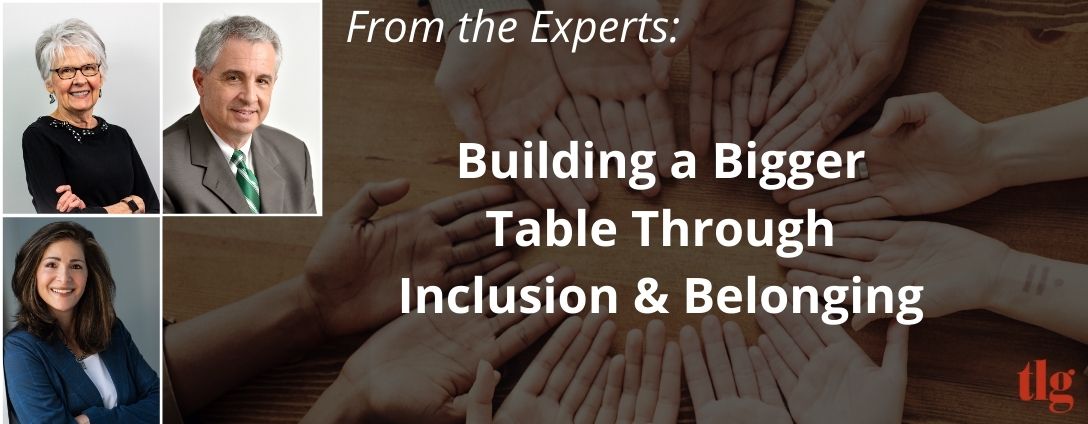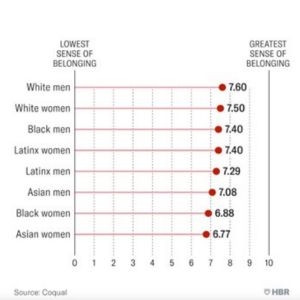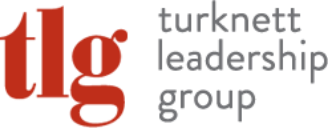
What would it take for an organization to create and nourish a culture of inclusivity and belonging? A culture where every employee feels valued and psychologically safe. Well, you’ve come to the right place. Read on to hear from our experts as they share from their own experiences and work how organizations and leaders alike can help foster cultures of inclusion and belonging that maximize employee potential.
Answers From the Experts:
 Lyn Turknett,
Co-founder and Co-chair, TLG
Lyn Turknett,
Co-founder and Co-chair, TLG
In your work with clients, how have you seen that nourishing a culture of inclusivity and belonging allows employees to maximize their potential and drive organizational goals?
We have always believed that a culture that makes every member of the organization feel included, one where everyone feels heard and everyone feels able to speak up, is a culture that leads to both high engagement and high performance. We also know, though (and we’ve seen it in our own engagement surveys), that in most organizations white men feel the highest sense of belonging, followed by white women. Black and Asian women feel the lowest sense of belonging. Research by Coqual, a nonprofit think tank focused on promoting diversity, equity, and inclusion, has confirmed that very recently. The chart below is from an HBR article authored by Coqual leaders.

Right now, research on psychological safety is exploding, and that concept is powerful in helping us all create cultures that help everyone feel that they belong. Amy Edmonson, author of “The Fearless Organization,” is the leading scholar on psychological safety. Interest exploded when Google research demonstrated that their highest-performing teams were primarily distinguished by one thing – higher psychological safety. Research by Shannon Harmon, a Ph.D. psychologist and Senior Advisor, Operational Excellence at Southern California Edison, shows that supportive leadership has a positive influence on psychological safety. Directive leadership has a negative influence. Directive leadership is often necessary, of course, but it must be balanced by supportive leadership. In the lingo of our Leadership Character Model, that means balancing Respect and Responsibility in every moment.
Harmon also found, in a very large study within the electric utility, that psychological safety is also critical for lowering accidents – it promotes a safety culture… We know that’s true in healthcare and aviation as well. In environments where safety is a matter of life and death, real inclusion, and the feeling of belonging that implies, is the key to open communication and accident avoidance.
We’ve seen many, many leadership transitions – at the top of companies and in large departments and divisions. In every instance, when those are successful – when they lead to sustained and positive culture change, improved performance, improved engagement, and increased inclusion – the leaders begin by listening. They talk to individuals, they hold town halls, they eat in the cafeteria with everybody else, they start engagement surveys, they are open to feedback and criticism, and they make it clear that they are human.
We worked with Hewlett Packard when David Packard and Bill Hewlett were still leading the company. I’ll never forget a leader we were working with telling us that the founders would be as likely as anyone else in the room to crawl under a table to plug in a cord that had become unplugged. I’ve never forgotten that image.
Do you have an example you can share of an organizational leader stepping up to create a bigger table and a more inclusive workplace?
We have seen so many examples of this over the years, and, as mentioned in my answer to the first question, every truly effective new leader I’ve ever seen always begins with a strategy of listening – of making everyone feel heard. While we think of inclusion and belonging as most needed for those who are marginalized, belonging is simply a core human need. And NO PERSON working in a culture of fear and intimidation can do their best work or create a safe environment for customers or patients. A foundation of character is essential.
In thinking about this question, I thought about one of the largest transitions I’ve seen – one that took place over twenty years ago. We were working with a very larger telecommunications firm, BellSouth, and Rod Odom had taken over as president of the network organization, the part of the company that included all the technicians, engineers, and construction crews that built the infrastructure and kept the system up and running.
He really wanted to transform the culture of the organization – an organization that was about 35,000 people strong. He focused on two things: he wanted to personally lead in a way that was less hierarchical and more respectful, and he wanted his front-line supervisors to do the same. What he did reminded me of what Alan Mulally did at Ford – he took an engineering culture that was heavily focused on measurement and accountability (but one that was sometimes more focused on making the numbers look good than being accurate and helpful) and added humanity.
Geographically the network was spread over nine southern states, and Rod would spend a lot of time in the field visiting local centers. Rod was a fan of the Leadership Character Model, but he did more than talk about it – he tried to live it. Something he said once in conversation stuck with me. He said something like, “Most leaders who have been in my role, when they go out to local centers, they pull together the crews and talk to them from the bed of a pickup truck. I decided the look of that sends the wrong message. I’m just standing on the ground – we’re all in this together.”
That’s a small thing, but every culture is built on small moments.
 Len Romano,
Sr. Consultant, Not-for-profit Practice, TLG
Len Romano,
Sr. Consultant, Not-for-profit Practice, TLG
In your work with clients, how have you seen that nourishing a culture of inclusivity and belonging allows employees to maximize their potential and drive organizational goals?
During my time as a CEO in the nonprofit sector, one issue that impacted every organization I was responsible for was losing high-performing staff members to school districts with higher starting salary ranges. Contributing to the issue were antiquated “science-based” salary policies not based on the reality of the marketplace. The solution was not to return to the HR department to “re-rate” each job category…instead, enter the BIG TABLE Process.
Step 1: Setting the Table
We invited all the full-time exempt staff members to attend a BIG TABLE for an introductory meeting to acknowledge the issue and to get their commitment to work on the process with me. The VP of HR intentionally stayed in the background but was there to ensure we complied with state/federal laws. Next, we created guardrails to ensure that the results would be true to the issue of outdated salary ranges not being in sync with the general marketplace. We agreed that salary ranges and performance expectations are two different issues.
Step 2: Conversations at the Table
We divided the 100 staff members into four sub-tables based on their specialty area with one guardrail: determine what would be a competitive entry-level, midpoint, and endpoint salary for your area. Each sub-table came together, and the outcome was interesting – their salary ranges were very similar, resulting in the group selecting what they felt was the best option. During TABLE conversations, I also found we were hurting ourselves as our executives were losing key staff to other branch locations within our organization due to salary ranges that differed by position type.
Step 3: Organizing the Table
With the salary ranges (entry level, midpoint, endpoint) finalized, each group returned to their sub-table to create the requirements that staff members needed to obtain certain salary point levels, i.e., certification/training requirements, budget size responsibilities, organization-wide leadership involvement, etc. The BIG TABLE Process ended with individuals placing themselves at the appropriate salary level based on the requirements that the sub-tables created. And then, of course, actual pay rates were adjusted for everyone. The outcome was immediate. Staff retention increased, and people felt included and involved in the project while building mutual trust overnight.
It is not always possible to involve everyone in organization-wide issues, but with the right guardrails, a diverse representation of your workforce, and a sincere attitude to lead the process – the BIG TABLE concept can work. Give it a try and let us know how it works out! If you need help getting it started, we are here for you!
 Laurie Arron, CPCC, PCC,
Strategic Partner, TLG
Laurie Arron, CPCC, PCC,
Strategic Partner, TLG
In your work with clients, how have you seen that nourishing a culture of inclusivity and belonging allows employees to maximize their potential and drive organizational goals?
As an executive coach to senior leaders, I continue to observe the transformative impact of a culture rooted in inclusivity and belonging, driving the success of both employees and organizations. Leaders who wholeheartedly embrace diversity and inclusion create an atmosphere where their teams can tap into their best creative thinking. By nurturing authenticity, these leaders ignite innovation and passion, plus drive collaboration and teamwork. Engaged and loyal employees are fueled by this type of environment and it results in heightened motivation and increased productivity. Then, on top of it all, the organization’s inclusive reputation can attract valuable talent.
Do you have an example you can share of an organizational leader stepping up to create a bigger table and a more inclusive workplace?
Many senior leaders I work with are trailblazers when it comes to inclusivity initiatives at a bigger scale. They are focused on this from the ground up. Many have created diversity councils, offered new training and mentor programs, and they’ve also been transparent about hiring and promoting processes, among others. It’s a huge cultural shift and there are sometimes struggles to get the buy-in from all team members
One CEO I worked with did a great job in explaining the why and getting everyone involved. He communicated the purpose effectively and embodied the values and behaviors associated with inclusivity. His words and actions inspired others to follow suit. He also encouraged the input, ideas, and feedback of team members to shape the new initiatives.
The biggest learning: When team members feel a sense of ownership and are actively involved, they are more likely to embrace and support those initiatives.
Explore the rest of our team!

